NCERT Solutions for Class 6 Science Chapter 13 Fun with Magnets
Topics and Sub Topics in Class 6 Science Chapter 13 Fun with Magnets:
| Section Name | Topic Name |
| 13 | Fun with Magnets |
| 13.1 | Magnetic and non-magnetic materials |
| 13.2 | Poles of magnet |
| 13.3 | Finding directions |
| 13.4 | Make your own magnet |
| 13.5 | Attraction and repulsion between magnets |
1. Fill in the blanks in the following:
(i) Artificial magnets are made in different shapes such as_________ ,_______ and
(ii) The materials which are attracted towards a magnet are called_________
(iii) Paper is not a________
(iv) In olden days, sailors used to find direction by suspending a piece of
(v) A magnet always has ________poles.
Ans:
(i) bar magnet, horse-shoe magnet and cylindrical magnet
(ii) magnetic materials
(iii) magnetic
(iv) bar magnet or lode stone
(v) two or a pair of
2. State whether the following statements are true or false:
(i) A cylindrical magnet has only one pole.
(ii) Natural magnets were discovered in Greece.
(iii) Similar poles of a magnet repel each other.
(iv) Maximum iron filings stick in the middle of a bar magnet when it is brought near them.
(v) Bar magnets always point towards North-South direction when suspended freely in air.
(vi) A compass can be used to find East-West direction at any place.
(vii) Rubber is a magnetic material.
Ans:
(i) False
(ii) True
(iii) True
(iv) False
(v) True
(vi) True
(vii) False
3. It was observed that a pencil sharpener gets attracted by both the poles of a magnet although its body is made of plastic. Name a material that might have been used to make some part of it.
Ans:
Iron is used to make some part of sharpener due to which it is attracted toward magnet.
4. Column I shows different positions in which one pole of a magnet is placed near that of the other. Column II indicates the resulting action between them for each situation. Fill in the blanks.
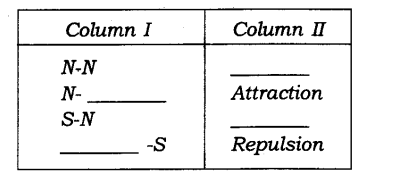
Ans:
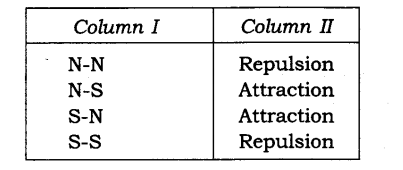
5. Write any two properties of a magnet.
Ans:
Two properties of magnets are:
(i) A magnet has two poles: North pole and South pole.
(ii) Like poles repel each other and unlike poles attract each other.
6. Where are poles of a bar magnet located?
Ans:
Poles are located at the ends of bar magnet just before the ends. These are north and south poles.
7. A bar magnet has no markings to indicate its poles. How would you find out near which end is its north pole located?
Ans:
Take the bar magnet and suspend it freely with the help of a thread, the end that points towards north pole will be regarded as north end of the magnet. Take a bar magnet with known/marked poles on it. Let the north pole of the magnet be brought closer to the suspended magnet at the end that is pointing towards north, if it shows repulsion than it is confirmed.
8. You are given iron strip. How will you make it into a magnet?
Ans:
Making a magnet: Take an iron strip and place it on the table. Now take a bar magnet and place one of its poles near one edge of the strip of iron. Without lifting it move it along the length of the iron strip till you reach the other end. Now lift the magnet and bring the pole to the same point of strip from where yob began. Repeat this process about 30-40 times. Bring some iron fillings near the strip and observe that the strip attracts the fillings. This indicates that the iron strip becomes magnet.
Remember that the pole of magnet and direction of its movement should not change.
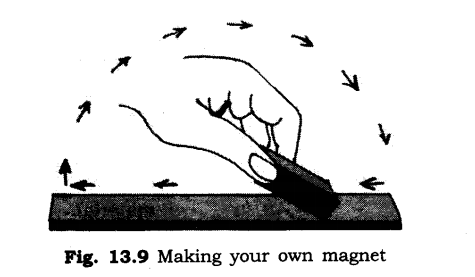
9. How is compass used to find direction?
Ans:
A compass is a small case of glass. A magnetised needle is pivoted inside the box. The needle can rotate freely. Compass also has a dial with directions marked on it. The compass is kept at the place where we want to know the directions. When the needle comes to rest it indicates north-south direction. The compass is then rotated until the north and south marked on the dial are at the two ends of the needle. Usually different colours are used to point the ends of needle to identify the north and the south poles.
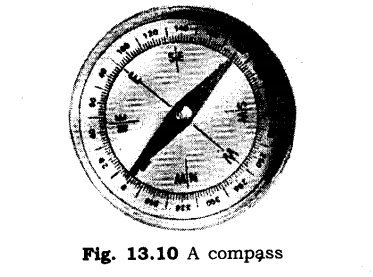
10. A magnet was brought from different directions towards a toy boat that has been floating in water in a tub. Effect observed in each case is stated in Column I. Possible reason for the observed effects are mentioned in Column II. Match the statements given in Column I with those in Column II.
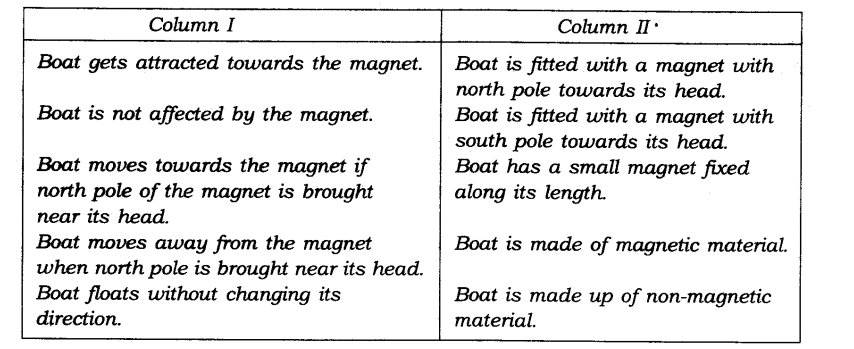
Ans:
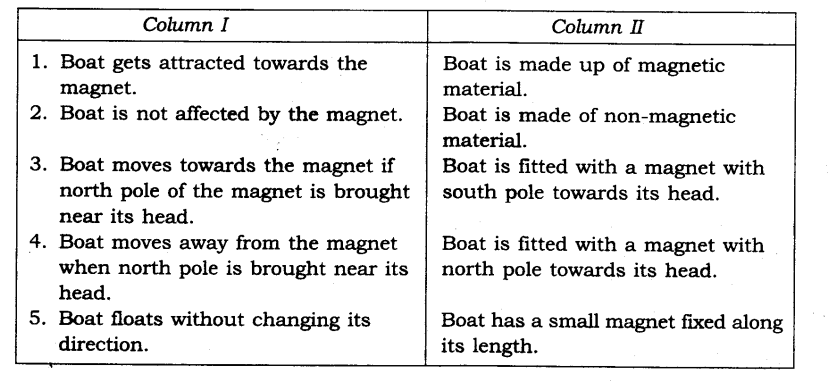
Class 6 Science Chapter 13 VERY SHORT ANSWER TYPE QUESTIONS
1. Name the compound of iron contained in lode stone.
Ans:
The compound of iron is iron oxide or magnetite.
2. Name the shepherd after which magnet was named.
Ans:
Magnets.
3. How can you separate a magnetic substance from a mixture?
Ans:
By using a bar magnet, the magnetic substance is separated from mixture.
4. At which place on a magnet, its magnetic force is maximum?
Ans:
At poles.
5. In which direction does a suspended magnet come to rest?
Ans:
Magnet comes to rest in N-S (north-south) direction.
6. What happens when N-pole of a magnet is brought near the N-pole of a suspended magnet?
Ans:
There is repulsion between these two magnets as there is repulsion between like poles.
Class 6 Science Chapter 13 SHORT ANSWER TYPE QUESTIONS
1. Draw the diagram of (a) Bar magnet (b) Horse-shoe magnet.
Ans:
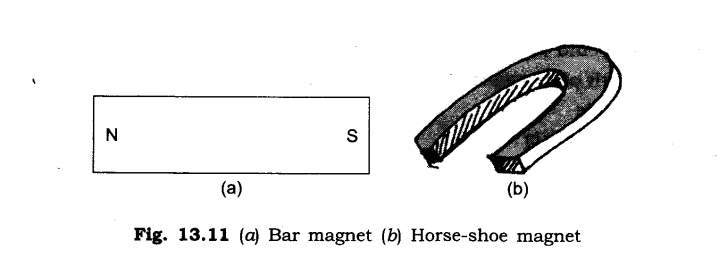
2.Identify magnetic and non-magnetic substances from the list given below:
Iron, Steel, Nickel, Plastic, Wood, Copper and a Stainless Steel spoon
Ans:

3. Draw a diagram of a magnetic compass.
Ans:
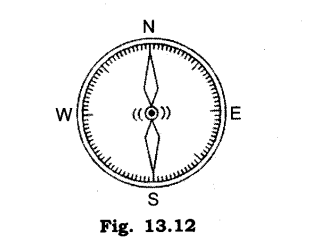
4. Write main properties of a magnet.
Ans:
(i) Magnet has two poles—south pole and north pole.
(ii) Poles of magnet cannot be isolated.
(iii) Like poles repel each other and unlike poles attract each other.
(iv) Freely suspended magnet aligns in N-S direction.
5.Write two methods by which a magnet can be demagnetised.
Ans:
(1) By hammering the magnet strongly.
(2) By heating a magnet strongly and keeping it in the east-west direction.
6. It is advised to keep the magnets away from television, mobiles, CD and computers
Explain why?
Ans:
Television, mobiles, CD, computers and many more devices are made up of magnetic materials and magnets in it. If you bring a magnet closer to it then it will spoil these devices.
7. Few iron nails and screws got mixed with the wooden shavings while a carpenter was working with them.How can you help him in getting the nails and screws back from the scrap without wasting his time in searching with his hands?
Ans:
With the help of a magnet we can attract all iron nails and screws and can separate them from the wooden shavings. As iron nails and screws are magnetic materials and will get attracted to the magnet,whereas wooden shavings are non-magnetic.
8. It is said that repulsion is a sure test for magnetism. Why is it so?
Ans:
To identify the magnet, repulsion (like poles of two magnets repel) is the only test which will let you know whether the given rod is an iron rod or a bar magnet. Because a magnet attracts an iron object and unlike poles of magnets also attract each other.
9. A given bar magnet was broken into pieces. Where will be its North and South pole?
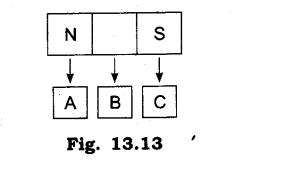
Ans:
If you cut a bar magnet into pieces then the end labelled as North remains north and the other end formed will be south. Similarly the end that was pointing south will be south pole and its opposite end will be the new north pole.
10. You are given two rods. Out of these, one is an iron rod and the other one is magnet, how will you identify these rods?
Ans:
Take both the rods and suspend them separately. Bring one end of a bar magnet close to both the ends of the suspended rod. If it shows attraction at both the ends then it is an iron rod. If it shows attraction at one end and repulsion at the other end then it is a bar magnet.
Class 6 Science Chapter 13 LONG ANSWER TYPE QUESTIONS
1. Show that a magnet has two poles. What are the properties of the poles of a magnet?
Ans.
We know that pole is the point where the strength of the magnet is maximum. So more and more iron particles will be attracted at poles of a magnet when we bring a magnet near the iron particles. We will observe the crowdness of particles at the ends of magnet. This indicates the presence of two poles in a magnet. Hence poles are present in a magnet in pair. If a magnet is divided into two parts, each part also possesses a pair of poles.

NCERT Solutions for Class 6 Science – All Chapters
- Chapter 1 Food Where Does It Come From
- Chapter 2 Components of Food
- Chapter 3 Fibre to Fabric
- Chapter 4 Sorting Materials Into Groups
- Chapter 5 Separation of Substances
- Chapter 6 Changes Around Us
- Chapter 7 Getting to Know Plants
- Chapter 8 Body Movements
- Chapter 9 The Living Organisms and Their Surroundings
- Chapter 10 Motion and Measurement of Distances
- Chapter 11 Light Shadows and Reflection
- Chapter 12 Electricity and Circuits
- Chapter 13 Fun with Magnets
- Chapter 14 Water
- Chapter 15 Air Around Us
- Chapter 16 Garbage In Garbage Out